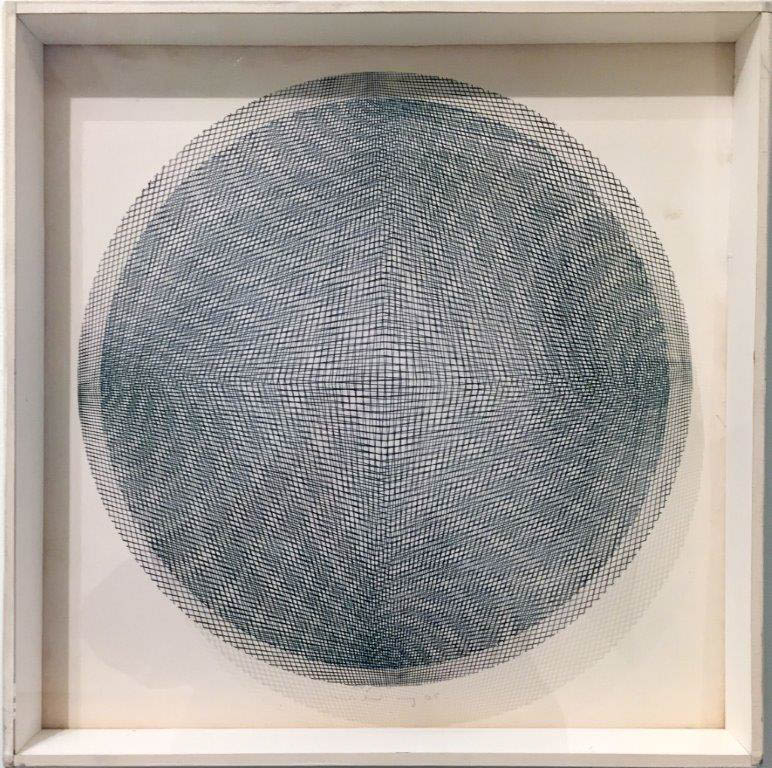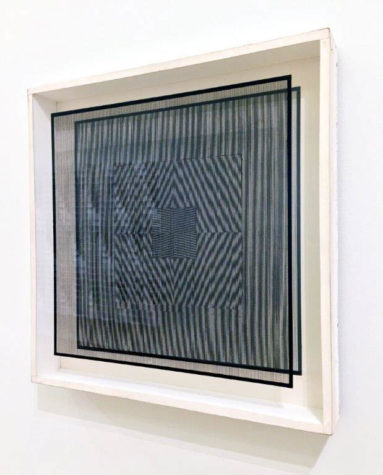
My first sighting of one of life’s everyday astonishments was as a little fellow in the 1960s, sitting unbuckled in the back seat of my family’s ’57 Chevy. Whenever we hit the highway on our way to the Jersey shore or the Lower East Side of Manhattan where my grandparents lived, we would approach and then zoom under overpasses, some of them flanked with metal fencing like two sides of a cage. Yep, I am talking about gritty transportation infrastructure here. But I coveted these drive-by encounters with highway overpasses, because I knew all I needed for a wide-eyed moment of wonder was to pay attention from the comfort of my 60-mph, backseat sofa.
It would begin when we were a few hundreds yards from the overpass. Even from there, the two-tiered fencing above the overpass would take on a roiling character, as though the heavy-gauge, chain-link mesh might be more like churning water than the stand-still metal I knew it was. In the next few seconds, as the angle between the paired fences and my ever-shortening line of sight subtly changed, a vignette of visual verve would silence my breath. In a way that surely must have seemed hallucinogenic to my kindergartner self (because it seems so to me now with a half-century under my belt), a morphing and increasingly tight diamond metapattern of black lines would overlay and slide across the fence faces like a liquid-geometric ghost. This would last a few seconds until we had passed the Goldilocks window in which the dynamic of fence-fence-eyes-visual cortex had been just right to elicit this optical effect. If I was quick enough to look out of the back window of the Chevy, I could sneak in a second morsel of eye candy as we raced away from the overpass.
I later learned these emergent visual surprises are known as moire patterns. The word moire likely derives from Arabic and then French words for mohair, which suggests a biological anchor for what now is an entire category of moire effect fabrics.
I can’t get enough of these moire moments and there are plenty to be had. Align any pair of identical patterns in which you can see one member of the pair through the other and they will appear to be just a single copy of the pattern. Straight lines, wavy or zigzag lines, arrays of dots of different sizes and separations, target-like sets of concentric circles, or any other repetitive motif will do. But shift the pairs of patterns out of alignment, the way two parallel fences above an overpass misalign as you approach them in a speeding automobile, and you will see a pattern—akin to interference patterns in electromagnetic and acoustic waves—of opaque and see-through regions different from those of the constituent patterns. That’s a moire, as Dean Martin might have crooned.
Moire effects lie in benevolent wait all over the place. I remember two examples from those 1960s pilgrimages to my grandparents’ house. Wherever the sheer white and scratchy fabric of my elders’ window curtains folded back onto itself, I would be captivated by a psychedelic moire show that was nowhere to be seen in a single ply of the material. And when I looked through one of the windows at a soot-black metal cage around an incinerator smokestack atop the building across the street, I would catch glimpses of a moire effect if I watched the cage as I slowly moved my head to the right or left.
My moire radar is on high alert these days. I have scored the effect in the cabling of the Brooklyn Bridge. The truss work of radio towers. The layers of taut mesh overlaying the frame of office chairs. The fine wire strainer hanging in my kitchen. A webbed sack for soccer balls. A window screen with a vertical-slat fence 20 yards behind it. And, of course, the chain-link, vertical-bar, and other kinds of patterned barriers on highways, along metro lines, and around construction sites.
Like a lifelong birder, I have always delighted in my moire sightings in the constructed wild. But my love for the effect was invigorated during a recent visit with my own grown son and his girlfriend to an exhibit of optics-centric art titled“The Illusive Eye” at El Museo del Barrio on upper Fifth Avenue in New York City. Moire was with us there. Two of the most striking examples were prepared by the German artist Ludwig Wilding during the same mid-1960s years when I was a wee one ogling moire effects on New Jersey highways.
In one of Wilding’s works, a see-through disc of diamond-patterned mesh printed on Plexiglas is suspended in front of a disc of the same mesh pattern screen-printed on paper at the back of the frame. In the other piece, a rectangle of vertical black lines on a Plexiglas pane overlays a more complex printed pattern in which vertical lines frame a central region of angled lines surrounding a yet differently patterned square core. These pieces turned gallery goers into happy fools, unconcerned by their comedic appearance as they swayed their heads back and forth, leaned this way and that, and gyrated their hips in what amounted to an accidental dance motivated by their desire to discover the diversity of arresting moire effects in Wilding’s works.

Moire patterns can have their dark side. In various print, photographic and video processes, several layers of an image, or frames of a video, can clash into unwanted moire effects (this is why video producers remind on-screen participants to avoid tight-patterned clothing). Wilding, on the contrary, demonstrated what becomes possible by applying artistic intentionality to the moire effect. At the exhibit, when I became one of those happy fools in front of his moire masterpieces, I was as wide-eyed with delight as I was a half-century earlier in the backseat of a ’57 Chevy.
Photos courtesy of Joanne Mattera Art Blog
Ivan, is this the same as in the Renwick exhibit, Gabriel Dawe’s Plexus A1 (detail) and Patrick Dougherty’s Shindig (detail) http://americanart.si.edu/exhibitions/archive/2015/wonder/? Very cool as you walk past it or even move your head.
Yes, it’s the same effect. I love the Renwick’s Wonder exhibit and my favorite piece in it is Dawe’s Plexus. I spent a lot of time walking around the piece while “ducking and weaving,” which you need to do in order to discover the various moire effects the piece can produce. Speed matters also. And, as you mention, the relative speed and angle of you (your eyes and brain) with respect to the patterns you are looking at, can influence the details of the moire effect you perceive.
Yes, it was my favorite too. We almost didn’t go because we thought they may have wrecked the Renwick. Glad they didn’t.
I started writing this comment about how interesting it would be to create a wind sculpture that had a moire effect. Then I used the Google Magic to see if one already existed. Here it is: https://www.youtube.com/watch?v=JQLFiYx7HbA